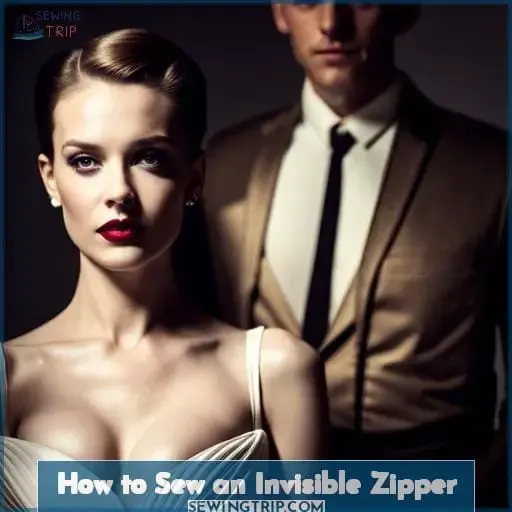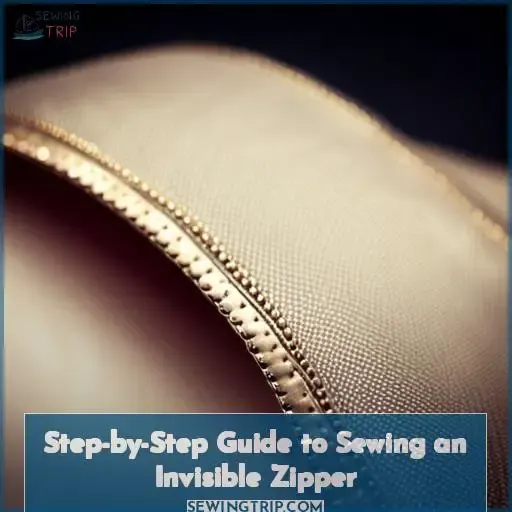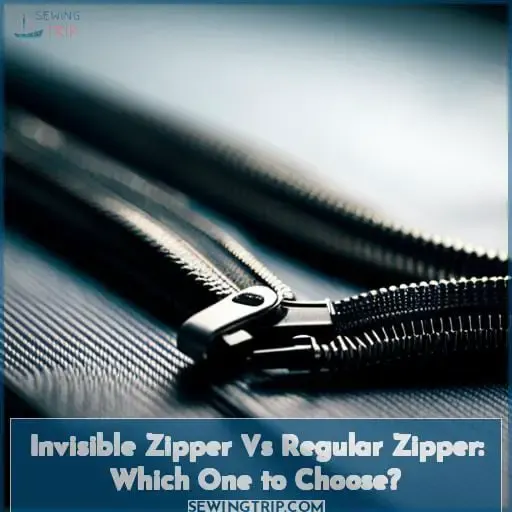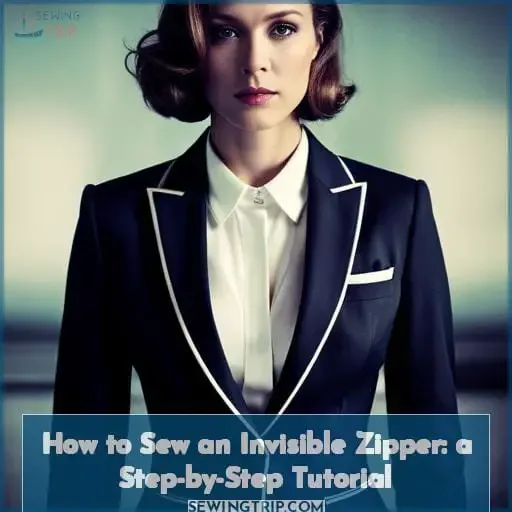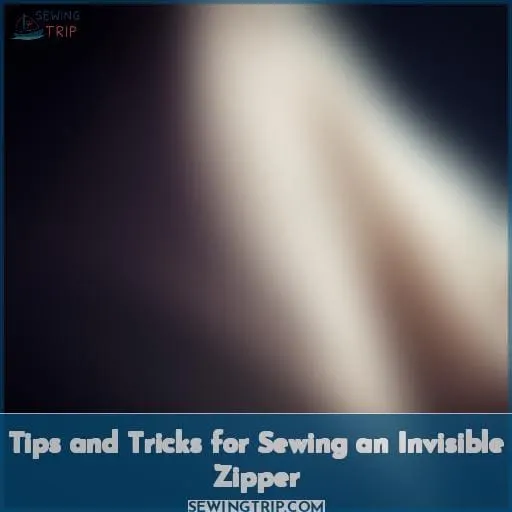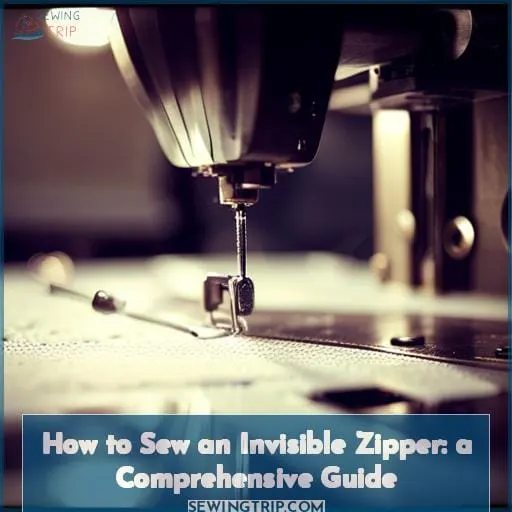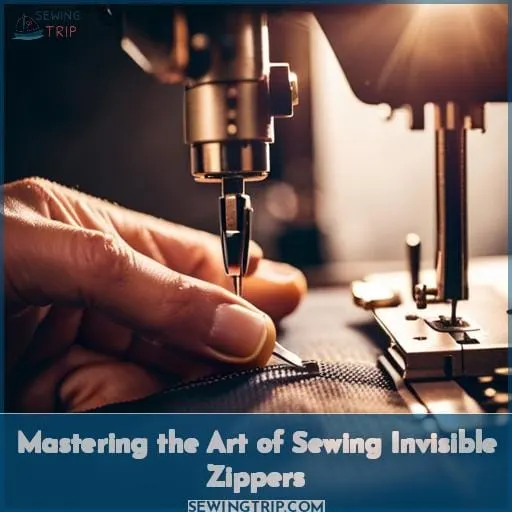This site is supported by our readers. We may earn a commission, at no cost to you, if you purchase through links.
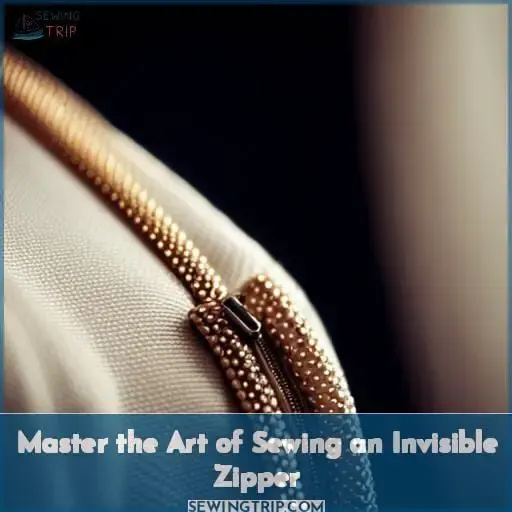 Refine your sewing skills by mastering the art of sewing an invisible zipper. This essential skill elevates your practice and takes it to the next level. While zippers can seem intimidating, learning this opens up creative expression opportunities in fashion design and tailoring.
Refine your sewing skills by mastering the art of sewing an invisible zipper. This essential skill elevates your practice and takes it to the next level. While zippers can seem intimidating, learning this opens up creative expression opportunities in fashion design and tailoring.
Invisible zippers subtly add closures to skirts, dresses, or other garments needing hidden seams.
Table Of Contents
- Key Takeaways
- How to Sew an Invisible Zipper
- Step-by-Step Guide to Sewing an Invisible Zipper
- Invisible Zipper Vs Regular Zipper: Which One to Choose?
- How to Sew an Invisible Zipper: a Step-by-Step Tutorial
- Tips and Tricks for Sewing an Invisible Zipper
- How to Sew an Invisible Zipper: a Comprehensive Guide
- Mastering the Art of Sewing Invisible Zippers
- Frequently Asked Questions (FAQs)
- Conclusion
Key Takeaways
- Prepare fabric edges for smooth zipper insertion.
- Mark zipper placement lines accurately.
- Iron zipper coils flat for a seamless look.
- Sew close to the zipper coil for a clean finish.
How to Sew an Invisible Zipper
If you want to add a polished touch to your sewing projects, an invisible zipper is just what you need, even though the installation can be tricky. First, you’ll need to prepare the fabric edges and mark where to place the zipper.
Then get the zipper ready and sew one side of it to the fabric. Next, pin the other side in place before stitching it down as well. After that, finish below the zipper and complete the garment seam. Don’t get discouraged if your first attempt isn’t perfect – follow these steps carefully and your invisible zipper will disappear seamlessly into the fabric for a flawless finish.
Materials Needed
- Invisible zipper
- Regular zipper foot or invisible zipper foot
- Fabric marker or pins
- Ruler and tape measure
- Thread and scissors
Gather your sewing tools with confidence, knowing you have everything required for zipper installation success. The fabric marker and ruler ensure proper placement, while quality thread and sharp scissors make quick work of cutting.
Most importantly, the correct zipper foot glides smoothly along the teeth – your invisible zipper mentor.
Preparing the Fabric
Let’s start by trimming any sharp edges so your zipper slides in smooth as butter. Carefully inspect the zipper, ensuring the teeth lie flat. Then finish the seam allowances, pressing or serging for a professional result.
Mark the fabric 3/4 from the top edge for zipper placement. Use wonder tape on slippery fabrics, pinning the zipper coil precisely within the 5/8” seam allowance. Properly sandwiching the zipper now prevents puckering later. With preparation complete, you’re ready to masterfully install this invisible zipper.
Marking the Zipper Placement
Once prepared, mindfully delineate the zipper placement lines. With your fabric edges finished, mark 3⁄4 down from the garment’s top edge on both front and back pieces – this indicates the zipper stop.
Then use your ruler to draw a vertical line 5⁄8 in from the garment edge to denote the zipper coil allowance. Be precise with zipper alignment for a flawless finish. Exact zipper positioning creates an invisible installation and liberates your inner couturier.
Follow these fundamental sewing techniques, and your garments will exude mastery.
Preparing the Zipper
Fold the zipper tape open and iron the coils flat with low heat to press them in place and prepare for stitching. This prep allows the zipper teeth to lie flat against the fabric, creating a smooth, invisible application once installed.
Align the zipper head near the fabric markings. First baste by hand if working with slippery material, securing the zipper’s position before permanent stitching. Proper preparation techniques like pressing, marking and alignment make sewing an invisible zipper easier.
Sewing One Side of the Zipper
With bated breath, pin the teeth in place and stitch that zipper down. Tentatively position your invisible zipper foot to the left of the zipper coils. Engage the needle slowly, embracing the fragile nature of this attachment. Let your actions show the poise only a skilled artisan has.
Perfect this technique through patient practice, freeing yourself from zipper intimidation.
Pinning the Other Side of the Zipper
Carefully clasp the remaining fabric over the zipper’s coils and fasten it with pins, cinching the fabric closed. With alignment as your guide, delicately pin the zipper into place. Finesse each tooth, concealing all hints of metal.
This artful fastening provides a smooth, unencumbered closure. Your stitches sing of freedom, while the zipper disappears. Celebrate this vanishing act, then lovingly caress the next seam. Mastery awaits you.
Sewing the Other Side of the Zipper
Now whipstitch along the marked seam allowance, keeping the coils flat and aligned with the fabric edges. Glide the invisible zipper foot along to secure the zipper tape, avoiding stretching or twisting it.
Backstitch at the ends for reinforcement. With concentration and care, your stitches will be straight, and the coils will align perfectly. This side matches the first, almost ready for zipper magic! It is satisfying to see your handiwork coming together.
Finishing the Seam Below the Zipper
Keep the needle hovering parallel and stitch the opening until you reach the hemline.
- Release the zipper tape now that it’s secured on both sides.
- Snip the zipper stopper.
- Sandwich and pin the rest of the zipper carefully.
- Let that foot glide over the teeth.
- Take it slow – there is no need to rush.
- Leave a little gap before you switch tracks.
- Admire that clean and invisible finish!
You did good, you mastered the invisible zipper install. Give yourself a pat on the back because that zipper looks slick.
Completing the Seam
Switch to your regular presser foot to continue sewing the seam all the way down, aligning the fabric edges precisely. Keep the zipper sandwiched neatly in the seam as you stitch, adjusting the zipper teeth as needed.
Take care not to sew over them! Manage bulk by trimming away excess seam allowances and grading.
Step-by-Step Guide to Sewing an Invisible Zipper
Hello there fashionista! Installing an invisible zipper takes a few key steps:
First, interface the seam allowance to help stabilize the fabric. Carefully examine the zipper to understand how it works before installing it.
When placing the zipper, be sure to correctly position it within the seam allowance. Then, use a zipper foot to neatly sew the zipper tape to the seam allowance on each side.
Stitch as close to the zipper coil as possible when topstitching for an invisible look. Double check your work by testing the zipper to ensure smooth operation. Finally, complete the installation by closing up the remaining back seam.
With careful prep and attention to detail, you’ll have a flawlessly invisible zipper install.
Interface the Seam Allowance
Stabilize the area by fusing a strip of lightweight interfacing to the seam allowance. This prevents stretching and rippling, ensuring the zipper tapes align perfectly. Interface the full length of the seam, taking care not to bulk up the zipper area.
Lightweight fusible interfacing works best – cut a 1 strip and fuse it to the wrong side of the fabric’s seam allowances. Now you can position the zipper correctly, achieving the smooth, invisible look desired.
Examining the Zipper
You’re evaluating that zipper now. Take a good hard look at the teeth before you stitch. Are they straight or crooked? Make sure the coil lies flat or your seam will bulge. Twist it to test the slider’s motion – it should glide smoothly up and down. Inspect for snags that could catch fabric or jam midway.
A dysfunctional zipper means frustration ahead, so replace it if anything is off. With a flawless zipper, you’ll achieve a seamless finish when it vanishes into the garment.
Finishing the Raw Edges
Before stitching, neaten your garment’s raw edges. Pull in any frays or threads by selecting the right finish for your fabric. For stable wovens, fold the allowance under and edgestitch. Lightweight knits and slippery fabrics benefit from zigzag or overlock stitching to bind the seam.
Serge for a clean, professional edge or simply overcast to prevent unraveling. Whichever method you choose, properly finishing the fabric will support your expert zip installation.
Placing the Zipper
Your heart’s guide rail slides into position for the journey ahead. Now comes the time to line up your zipper along the seam allowance. Prepare your fabric edges by finishing or pressing them flat. Then, lay the zipper coil right sides down, aligning the raw edges of the fabric.
Carefully pin the zipper in place, keeping it straight and taut. Consider hand basting for slippery fabrics. Next, attach your invisible zipper foot and stitch one side from top to bottom. The zipper is now perfectly positioned to complete the install.
Sewing the Zipper to the Seam Allowance
Carefully pin the zipper within the seam allowance and slowly stitch it in place. Proper zipper positioning and seam alignment now will create a polished, professional finish. Focus on keeping the zipper straight and taut as you attach it to avoid distortion.
Take your time and align meticulously, gently easing the fabric and zipper together. Master invisible zipper installation through patience and precision at this key step. Your attention to detail will be rewarded with a flawlessly smooth, invisible zipper and enviable garment construction skills.
Pressing the Zipper Teeth
Now press the zipper teeth flat using low heat. This pressing technique is crucial zipper preparation for a professional finish. With the teeth lying completely flat, your zipper will glide smoothly into seamless alignment.
Fabrics deserve this additional finesse before and after stitching. A flawlessly pressed zipper means perfection in your project.
Sewing Close to the Zipper Coil
At this point, double-check everything’s properly aligned before clamping down and stitching earnestly close to the teeth. Now you have your zipper sandwiched neatly in the seam allowance, so go ahead and pin it carefully in place.
Then switch to a standard zipper foot, positioning it just left of the zipper. Stitch real slow and steady near the coil, avoiding any bulk. Leave a tiny gap between your stitching lines for a clean finish. Zipper alignment, zipper foot, fabric preparation, and zipper inspection are key here.
Checking the Zipper Installation
Feel down the coils and across each side to confirm proper alignment before zipping. Gently tug the slider to check it glides smoothly without catching. Ensure both sides lie flat with no puckering or distorted fabric.
If alignment is off, carefully unpick a few stitches and re-pin for a flawless finish.
Sewing the Remaining Seam
Stitch away from the zipper to finish the garment. With your standard zipper foot in place, align the seam allowances with the right sides together. Pin carefully to sandwich the invisible zipper inside. Begin sewing the remaining seam slowly, keeping your stitches straight and even.
Take care not to catch any zipper teeth as you sew. Leave a slight gap between the zipper and the seam stitches for a clean finish. Your invisible zipper is ready to wear when you zip it up to admire the subtle, flawless fastening.
Invisible Zipper Vs Regular Zipper: Which One to Choose?
When choosing between an invisible zipper and a regular zipper for your sewing project, it’s important to consider the pros and cons of each. Invisible zippers provide a clean, seamless look perfect for more formal garments, while regular zippers offer versatility and are easier to install for beginning sewers.
You’ll need to evaluate the pattern, fabric, and overall look you’re aiming for when deciding which zipper is the best choice.
Evaluating your goals for the garment and your skill level can help determine if an invisible zipper’s sleek appearance or a regular zipper’s simplicity is the right fit. More formal fabrics tend to pair well with nearly invisible zippers, as their hidden teeth allow the fabric pattern or texture to really shine.
For everyday or casual pieces, a regular zipper may blend in fine with the fabric.
So weigh your project plans, abilities, and the final look you want to achieve. That will steer you towards selecting either an invisible zipper for its covert aesthetic or a regular zipper for its flexibility and ease of use.
Pros of invisible zipper
You’ll find invisible zippers give your projects a clean, sleek look. They disappear into garment seams for a smooth, professional finish. For a refined silhouette, opt for invisible zippers in unlined jackets, fitted dresses, skirts, and pants.
This prevents bulky zipper coils from marring the garment’s shape. Mastering invisible zipper installation allows you to finesse sleek closures in fine fabrics.
Versatility of regular zipper
Ironically, life’s journey has rough edges you can’t hide. A regular zipper offers versatility your creative spirit craves:
- More zipper types like metal, nylon, molded plastic teeth.
- Fashion accents like exposed color along a seam.
- Structure on blazers, trousers, luggage.
- Durability on outdoor gear, boots.
- Endless creative applications.
Choose the regular zipper’s edge and flexibility for your next project. Its options free your inner visionary.
Factors to consider
Whoo boy, installing an invisible zipper is more hair-raising than riding a bucking bronco on the Fourth of July! Consider the fabric, garment design, and your sewing skills when choosing between regular and invisible zippers.
Pick the right zipper for the job and you’ll be zipping up outfits in no time. Practice makes perfect – don’t let a tricky technique scare you off. With patience and perseverance, you’ll master the invisible zipper installation.
How to Sew an Invisible Zipper: a Step-by-Step Tutorial
Let’s get that invisible zipper sewn into your garment! First, finish the seam allowances. Next, mark a 5⁄8” seam allowance for the zipper placement as well as a line 3⁄4” down from the top edge.
This is where you will position the zipper. Pin the zipper in place along one side and begin sewing it from the top down. Don’t worry if you don’t get it perfect on your first attempt – with practice, you’ll be able to sew invisible zippers that look clean and professional in all of your makes.
Finishing the Seam
After stitching the zipper, flip the fabric right side out and press the seam open to finish it smoothly.
- Check zipper alignment.
- Press seam allowances open.
- Use low heat to avoid melting zipper teeth.
- Pin fabric away from zipper tape during pressing.
- Admire the clean finish!
With proper pressing technique, your invisible zipper will blend beautifully into the garment for a couture look. Aligning the zipper coils and pressing the seam open makes all the difference in achieving a flawless professional finish.
Marking the Zipper Position
Lay down your decree and mark up that zipper path, darling. Grasp your ruler and fabric marker to stake your claim on that zipper terrain. Plot those parallel lines 3/4 inch from the edge with precision. This is your domain – mark it boldly.
Position your zipper between those commanding stripes and baste it down dutifully. Your steadfast preparation guarantees a seamless reign over your zipper realm. Wield your measuring tape mightily as you survey your kingdom.
Sewing the First Edge
Pin one side of your zipper to the seam allowance, then take it slow as you stitch from top to bottom using that handy invisible zipper foot. Keep the zipper teeth flat against the fabric as you align the top marks. Take care when pinning slippery material so it doesn’t shift during sewing.
Use homemade fabric weights if needed for stability. Your zipper foot helps feed the coil in place. Go slowly, lifting the foot to pivot at the bottom. Proper alignment is vital here for a flawless zipper installation.
Tips and Tricks for Sewing an Invisible Zipper
When installing an invisible zipper, precision is key for a clean, professional finish. To keep the zipper teeth perfectly aligned, use pins for ease when hand-basting, and Wonder Tape for precise placement of the zipper coil before stitching.
Using Pins for Ease
Y’all just gotta watch your fabric and make sure it’s stretched before you pin it, honey.
- Mark the seam allowance.
- Use more pins near curves.
- Space pins 2-3 inches apart.
- Insert pins perpendicular to the edge.
- Avoid distorting the fabric.
Keep practicing your pinning, and you’ll be a pro in no time! Those pesky seams will lay flat and smooth as butter.
Using Wonder Tape for Precision
Using Wonder Tape for Precision
You’ve tackled those tricky zips before, so trust your skills and go for it! Using wonder tape for precision when installing invisible zippers is a game changer. Simply apply the tape along the zipper seam allowance to secure the zipper in place.
The adhesive holds everything steady as you sew, preventing shifting and puckering.
How to Sew an Invisible Zipper: a Comprehensive Guide
Thread gently through treacherous terrain and your path will emerge refined. Installing an invisible zipper may seem daunting, but with care and precision, a clean finish is within reach. Focus on aligning the zipper coils and maintaining even seam allowances. Go slowly, pivoting at the zipper’s base.
Your feed dogs are allies if you let them grasp just a sliver of zipper tape. Keep the teeth flat, nestling in the lush fabric. Celebrate small victories; a perfectly pressed seam concealing traces of the journey is an accomplishment.
Patience and persistence transform the trailblazing trek into a highway to liberation. With each zipper under your belt, claim your power. You’ve mastered the invisible zipper.
Mastering the Art of Sewing Invisible Zippers
Hang in there—bumpy seams ahead on the zipper trail. Getting the invisible zipper right will elevate your garments, darling. Start with quality zippers; they glide like butter. Tame slippery fabrics by basting the zipper in place.
Mind the skinny teeth! Position your zipper foot just so, then stitch slowly and steadily. Check alignment often to keep things straight and narrow. If you veer off course, gently rip and redo.
With practice, you’ll become a zipper pro. Your garments will move with effortless flow, concealing your handiwork. Soon you’ll crave the serene satisfaction of a perfectly hidden zip. Chin up, darling.
Frequently Asked Questions (FAQs)
The invisible zipper I installed is wavy or crooked. What did I do wrong and how can I prevent this next time?
You likely didn’t keep the zipper teeth flat enough while sewing. The next time, first press the zipper well and pin it very carefully. Move slowly, keeping the zipper foot directly against the teeth as you sew to avoid waviness.
Conclusion
Sewing an invisible zipper may seem intimidating, but with the right set of tools and keen eye for detail, you can master the art of invisibility. After preparing the seam allowances and marking the zipper placement, prepare the zipper.
Then you can start sewing your zipper with confidence by following this step-by-step guide. This will ensure a neat and professional finish. Don’t forget to add a few finishing touches to take your invisible zipper to the next level.
With a little practice, you’ll be able to zip up beautiful garments with ease. So take a deep breath, grab your materials, and get ready to sew your way to invisible zipper perfection.

